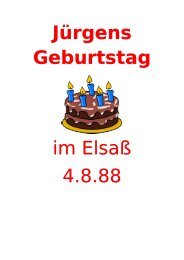USA April 88
New Mexico und Arizona. Florida mit BD Münster
New Mexico und Arizona. Florida mit BD Münster
Erfolgreiche ePaper selbst erstellen
Machen Sie aus Ihren PDF Publikationen ein blätterbares Flipbook mit unserer einzigartigen Google optimierten e-Paper Software.
Rising some 2OO feet above the valley foor, El Morro is a massive mesapoint
of sandstone, forming a striking landmark. ft was named by the Spanish
conquistadors who used the place, with its large natural basin of rain and
melted snow, as a camping spot in the lTth century. The Spanish word
"morro" means "headland," or
t'blufi."
These sheltered coves also served
later Anterican travelers to the Vest.
Many of the travelers left a record of their passage by cutting inscriptions
into the soft sandstone, thus giving the landmark its other name of ..fnscription
Rock." Two years before the founding of Jamestown, and 15 years before
the Pilgrims larrded at Plymouth Rock, the first Spanish inscription was made
by Don Juan de Ofrate in April 1605.
But the Spaniards were not the 6rst to record their presence. On the very
top of El Morro lie ruins, still largely unexcavated, of Zufti Indian pueblos
abandoned long before the coming of the Spaniards. And carved on the rock
itself are hundreds of petroglyphs left by these ancient people.
The inscriptions carved in stone at El Morro can be likened to a register of
modern fndians, and the people of Spain, Mexico, and the United States. As
such, it symbolizes the cultural mixture that took place in the Southwest,
which today exhibits a manner of living that is highly distinctive.
Vithin a few months a punitive expedition came to Zufü flrorn Sante F'e
and left this inscription on El Morro: "They passed on March 23, 1632, to
the avenging of the death of Father ls11ad6.-luj2n."
The "Seven Cities of Cibola"
In the years following the con"quest of Mexico, stories reached the Spaniards
of seven golden cities far to the north, called Cibola. The actual basis
for the rumor was simply the six villagbs ot the Zuf,i Indians, whose own
words for themselves and their country today are words not unlike Cibola.
The story of the seven cities was stimulated especially by the arrival in
Mexico o{ Alvar Nufiez Cabeza de Vaca, in 1536, after 8 years of wandering
westward from the gulf coast of Texas, during which he heard of the pueblos
of New Mexico.
In 1539, a Franciscan, Fray Marcos de Niza, traveled nothward up the
west coast of Mexico in seatch of Cibola, guided by Cabeza de Vaca's companion,
the Moorish slave Estevan. Estevan traveled far ahead of Fray
Marcos and was killed by the Zuäis. Word of his death reached the friar
somewhere in Arizona. Flistorians disagree as to whether Fray Marcos himself
actually reached Cibola.
The following yeat, Fray Marcos accompanied the famous expedition of
Francisco Vasquez de Coronado, which on July 7, 154O, took Hawikuh, the
first or southeffrmost of the six ZuÄi pueblos, and spent the rest of the summer
there before going eastward to the Rio Grande, probably passing El
Morro on the way to Äcoma.
The first post-Coronado expedition, that of Chamuscado and Rodriguez
in 1581, came up the Rio Grande and then traveled overland to Zuffi, passing
by Äcoma and, probably, El Morro. The expedition of 1583, headed by
Antonio de Espejo and Fray Francisco Beltran, also came from Äcoma to
Zufü, cettainly by way of El Morro, which is mentioned in the journal of
Diego P6tez de Luxän, as "El Estanque del Pefiol"-The Pool by the Great
Rock.
In October 1672, therc was another death at Hawikuh, when raiding
Apaches sacke{ the church and killed Fray Pedro de Ayala, who had been
assigned there only 2 months before,
Rebellion and Reconquest
The fnal violence-and the third death-----occurred at Flalona (Zufü) and
was one of a group of simultaneous killings. Spasmodic native resistance to
the Spanish conquistadors culminated in a plot by which, in August 168O,
all the pueblos rose in revolt, killing priests and laymen at the pueblos. Fray
Juan del Bal was killed at ZuÄi, and the church was burned.
The first stage in the Spanish reconquest came in 1692, when Don Diego
de Vargas, with a small force, visited all the pueblos and, without bloodshed,
received their submission to the Spanish crown. De Vargas followed the usual
route from Äcoma via El Morro to Zufü, and on to the Hopi villages. He
returned by way oL ZuAi to El Morro, but on leaving El Morro he struck
out southeastward for Socorro and El Paso. Perhaps it was just before taking
this new route that de Vargas left his inscription on the rock: ttFlere was the
General Don Diego de Vargas who conquered for our Holy Faith, and for
the Royal Crown, all of New Mexico at his own expense, yeat ol 1692."
H$



